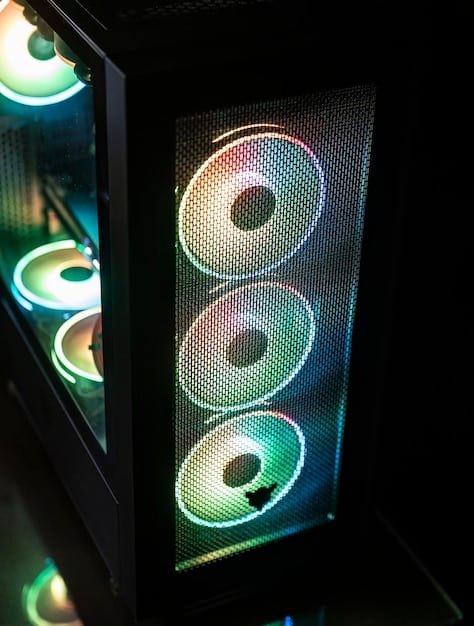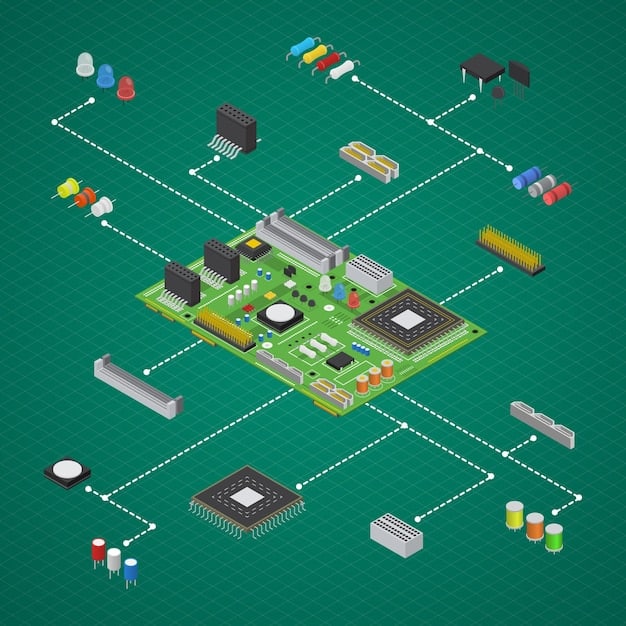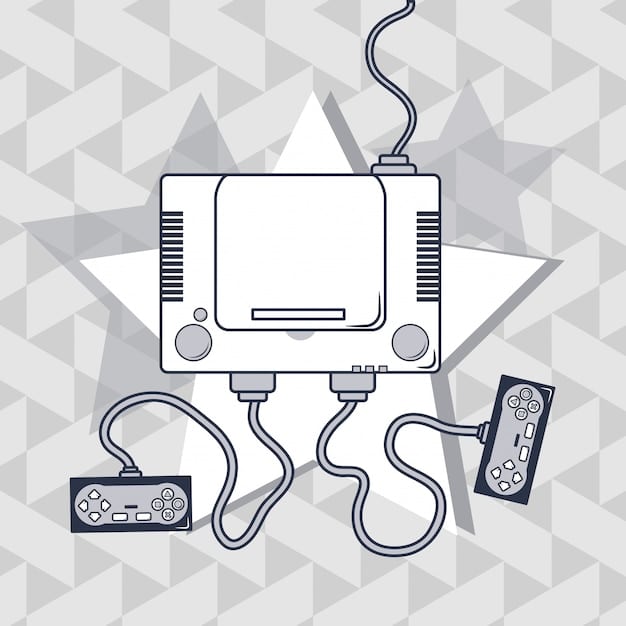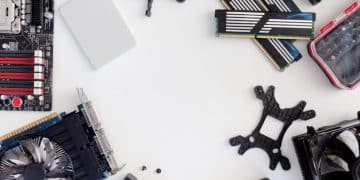Build a Budget Gaming PC Under $800 in 2025: The Ultimate Guide

Building an affordable yet powerful gaming PC for under $800 in 2025 is entirely feasible with careful component selection, strategic purchasing, and a clear understanding of performance priorities, enabling access to current and upcoming game titles without breaking the bank.
Embarking on the journey to assemble your own gaming PC can seem daunting, especially whenbudget constraints are a factor. However, with the right knowledge and a strategic approach, a powerful and cost-effective machine is well within reach. This piece serves as The Ultimate Guide to Building a Budget Gaming PC for Under $800 in 2025, offering a comprehensive roadmap for enthusiasts and newcomers alike to navigate the complexities of PC building.
Understanding the Budget Gaming PC Philosophy
Building a budget gaming PC isn’t about compromising on fun; it’s about making smart choices to maximize your dollar-to-performance ratio. In 2025, the landscape of PC components has evolved, offering more efficient and powerful options at lower price points than ever before. The core philosophy centers on identifying essential components that deliver the most significant impact on gaming performance while recognizing where cost-saving measures can be applied without detriment.
This approach involves prioritizing key hardware like the CPU and GPU, which are the heart and soul of any gaming rig. However, it also means being pragmatic about other components, such as storage and RAM, where overspending can quickly inflate the total cost without significant gains in frames per second (FPS). The objective is to achieve a balanced system—one that handles modern games at playable frame rates and resolutions, typically 1080p, with acceptable graphic settings.
Optimizing for Value: New vs. Used Components
The quest for a sub-$800 gaming PC in 2025 often leads to a crucial decision: to buy new, used, or a mix of both. New components offer warranties and the latest technology, but come at a premium. Used components, especially GPUs and CPUs from previous generations, can offer significant savings but require careful vetting to ensure functionality and longevity.
- New Components: Ideal for critical parts like the power supply unit (PSU) and sometimes the motherboard, where reliability and compatibility are paramount.
- Used Components: Excellent for scoring high-value deals on processors and graphics cards, often from previous generations that still pack a punch.
- Refurbished Items: A middle ground, often coming with limited warranties, offering a balance between cost savings and peace of mind.
For a budget build, embracing a hybrid approach often yields the best results. For example, opting for a slightly older but powerful used GPU can free up funds for a brand-new, reliable power supply or a faster SSD, significantly enhancing the overall user experience.
Furthermore, staying updated on component pricing trends and clearance sales is vital. Retailers frequently discount older stock, and these windows of opportunity can be incredibly beneficial for budget builders. Patience and consistent monitoring of hardware deals are virtues that pay off handsomely in this endeavor, allowing for strategic purchases that align with the $800 target.
Selecting the Core Components: CPU and GPU
The central processing unit (CPU) and graphics processing unit (GPU) are the bedrock of your gaming PC. Their synergy determines your system’s gaming capabilities. For an under-$800 build in 2025, the goal is to find a CPU and GPU combination that offers strong 1080p performance without excessive bottlenecks, balancing their individual strengths against your overall budget.
When selecting a CPU, focus on options that provide sufficient core count and clock speed for modern gaming, which is increasingly multi-threaded. AMD’s Ryzen 5 series and Intel’s Core i5 line are typically excellent starting points in the budget category, offering a compelling blend of performance for gaming and general computing tasks. Look for last-generation models that have seen price drops, as they often deliver near-current generation performance for significantly less.
The GPU is arguably the most critical component for gaming performance. In 2025, the budget GPU market has seen considerable advancements. GPUs in the sub-$300 range can now deliver impressive 1080p gaming experiences. Focus on models from AMD’s Radeon RX series or NVIDIA’s GeForce GTX/RTX series that offer at least 8GB of VRAM, which is becoming increasingly important for texture loading in modern titles. Considering used GPUs here can unlock higher performance tiers that would be unattainable with new parts within the budget.
Balancing CPU and GPU Performance
A common pitfall for budget builders is creating a significant bottleneck, where one component is vastly more powerful than the other, limiting the system’s overall potential. The aim is a harmonious pairing. For instance, a high-end GPU paired with a low-end CPU will result in the CPU holding back the GPU’s potential, leading to lower frame rates. Conversely, an overqualified CPU with an underpowered GPU will leave graphics performance wanting.
Researching benchmarks for various CPU and GPU combinations, especially in the games you intend to play, is crucial. Websites and YouTube channels dedicated to PC hardware reviews are invaluable resources for this. Pay close attention to “bottlenecking” tests that show how different component pairings perform under various workloads. Generally, for a gaming-first PC, slightly more budget allocation towards the GPU yields better frame rates, assuming the CPU is capable enough to provide consistent data.
As of 2025, entry-level CPUs like an older Ryzen 5 3600 or an Intel Core i5-10400F, when paired with a GPU such as a Radeon RX 6600 or GeForce RTX 3050, present a strong foundation for 1080p gaming. These combinations strike a compelling balance, allowing most games to run smoothly on medium to high settings. Don’t overlook the importance of monitoring price drops and comparing performance metrics across different retailers to snag the best possible deals.

Memory (RAM) and Storage Solutions
While the CPU and GPU handle the heavy lifting, sufficient memory (RAM) and fast storage are crucial for a smooth gaming experience and overall system responsiveness. For an under-$800 gaming PC in 2025, careful consideration here can prevent frustrating load times and stuttering.
When it comes to RAM, 16GB is the sweet spot for modern gaming. While 8GB might suffice for some older or less demanding titles, 16GB provides ample headroom for multitasking, running game launchers, and preventing performance hitches in graphically intensive games. The speed of the RAM also plays a role, especially for AMD Ryzen CPUs. Aim for DDR4 RAM with speeds around 3200MHz to 3600MHz, as this offers a good balance of performance and cost efficiency. Prices for DDR4 have become quite competitive by 2025, making 16GB an achievable target within a budget.
Optimizing Storage: SSDs and HDDs
Storage is another area where strategic choices can significantly impact user experience. The advent and affordability of Solid State Drives (SSDs) have revolutionized PC performance. For a gaming PC, an SSD for your operating system and primary games is non-negotiable.
- NVMe SSD: These are the fastest type of SSDs, connecting directly to the motherboard via a dedicated slot. A 500GB NVMe SSD is an excellent starting point for the OS and a few frequently played games.
- SATA SSD: Slightly slower than NVMe but still vastly superior to traditional Hard Disk Drives (HDDs). A 1TB SATA SSD can be a cost-effective solution for a larger game library.
- HDD: While slower for games and the OS, HDDs still offer the best cost-per-gigabyte for large storage needs. Consider adding a 1TB or 2TB HDD for storing less frequently played games, media files, and other documents if the budget allows after securing an SSD.
In 2025, 500GB NVMe SSDs have become quite affordable and should be prioritized. You’ll immensely appreciate the snappy boot times and quick game loads. If your budget is particularly tight, a 250GB NVMe for the OS and a few essential games, coupled with a larger, slower HDD for bulk storage, is a viable compromise. The key is to avoid relying solely on an HDD for your primary drive, as this will noticeably degrade your overall system responsiveness and gaming experience, even with powerful CPU and GPU components.
Motherboard and Power Supply Considerations
While not as flashy as CPUs or GPUs, the motherboard and power supply unit (PSU) are critical components that ensure system stability, longevity, and future upgradeability. Skimping on these can lead to frustrating compatibility issues or, worse, component failure. For an under-$800 budget build in 2025, smart choices here are paramount.
The motherboard acts as the central nervous system of your PC, connecting all components. Its selection is primarily dictated by your chosen CPU’s socket type (e.g., AM4 for older AMD Ryzen, LGA1200 for older Intel). Opt for a motherboard that provides sufficient USB ports, SATA ports (for SSDs/HDDs), and adequate RAM slots (at least two, preferably four for future upgrades). Basic B-series chipsets for both AMD and Intel usually offer the best value for budget builds, providing essential features without the premium cost of higher-end enthusiast boards. Ensure it supports your chosen RAM speed.
The power supply unit (PSU) directly impacts the stability and safety of your system. A cheap, unreliable PSU can damage components or cause system crashes. Never cheap out on the PSU. Aim for a unit from a reputable brand (e.g., Corsair, EVGA, Seasonic, Cooler Master) with at least an 80 PLUS Bronze efficiency rating. Calculate your total system’s power draw using online calculators (summing up CPU, GPU, storage, and other components) and add a buffer of at least 100-150W. A 500W to 650W PSU is typically sufficient for most budget gaming builds and allows for potential future GPU upgrades. Modular PSUs offer better cable management but are often more expensive, so a non-modular one is perfectly fine for budget consciousness.
Case and Cooling: Aesthetics and Airflow
The PC case is more than just an enclosure; it dictates airflow, component compatibility, and overall aesthetics. For a budget build, focus on functionality over flashy features. Look for a case that offers good airflow, with options for front and rear fans to create a positive pressure system (more intake than exhaust) to keep dust out and components cool. Room for a decent CPU cooler and your chosen GPU is also important. Many affordable cases come with pre-installed fans, which can save a few dollars.
Cooling is often an afterthought in budget builds, but it’s vital for component longevity and maintaining performance under load—especially for CPUs. Most CPUs come with a stock cooler that is adequate for basic use, but for gaming, a basic aftermarket CPU cooler for around $20-$30 can significantly improve temperatures and reduce noise levels. Air coolers offer the best value here. Ensure your chosen cooler fits within your case’s dimensions and doesn’t interfere with RAM modules.
A well-chosen motherboard offers the right balance of features for your chosen components without unnecessary expense. A reliable PSU protects your valuable hardware investments. And a functional case with good cooling ensures your components operate efficiently and quietly, extending their lifespan. Prioritizing these “behind the scenes” components ensures a stable and enjoyable gaming experience.
Assembly Process and Software Setup
Once all your components are gathered, the exciting phase of assembly begins. Building a PC is often likened to assembling a high-tech LEGO set, but with a bit more precision. Take your time, consult your component manuals, and refer to online video guides. Many reputable tech channels provide detailed, step-by-step assembly tutorials that can turn a potentially intimidating process into a fun and rewarding experience.
Before you start, ensure you have an anti-static wrist strap or regularly touch a grounded metal object to discharge static electricity, which can damage sensitive components. Lay out your tools: a Phillips head screwdriver, zip ties for cable management, and maybe a small bowl for screws. The general assembly order typically involves installing the CPU and cooler onto the motherboard first, then memory, followed by mounting the motherboard in the case. Next come the GPU, storage drives, and finally, connecting all the power cables from the PSU.
Operating System and Driver Installation
After physical assembly, the software setup is the next crucial step. Installing your operating system (OS), typically Windows 10 or 11 for gaming, is straightforward. You’ll need a USB drive with the OS installer, which can be created using Microsoft’s Media Creation Tool. Boot from the USB, follow the on-screen prompts, and install the OS onto your chosen SSD.
Post-OS installation, the most critical step is installing the correct drivers for your components, especially your GPU, motherboard chipset, and network adapter. Drivers are software programs that allow your OS to communicate effectively with your hardware. Outdated or missing drivers can lead to performance issues, instability, or even prevent certain features from working.
- GPU Drivers: Download the latest drivers directly from NVIDIA or AMD’s official websites. These are usually packaged with optimization software for gaming.
- Chipset Drivers: Get these from your motherboard manufacturer’s website or AMD/Intel’s site. They are crucial for optimizing communication between your CPU and other components.
- Other Drivers: Install drivers for your network adapter, audio chipset, and any other peripherals directly from the manufacturer’s websites to ensure full functionality.
Finally, ensure your Windows installation is fully updated, and then proceed to install your favorite games and gaming platforms (Steam, Epic Games Store, etc.). Taking the time to properly install and update all necessary software after assembly ensures your new budget gaming PC performs at its peak, providing a stable and enjoyable gaming experience from day one.
Expected Performance and Upgrade Paths
A budget gaming PC built for under $800 in 2025 will be a capable machine primarily focused on 1080p gaming. You can realistically expect to play most modern AAA titles at medium to high settings, achieving playable frame rates (typically 30-60+ FPS, depending on the game and optimization). Competitive shooters and less demanding titles will likely comfortably run at higher frame rates, pushing into the 100+ FPS range, especially with optimized settings.
While 1440p gaming might be possible in some older or less graphically intensive games, it won’t be the primary target resolution for this build. The performance will vary greatly depending on the specific CPU and GPU combination you choose and the individual game’s demands. Remember, the $800 price point forces strategic compromises, but these compromises are designed to maximize gaming value without sacrificing the core experience.
Future-Proofing and Upgrade Strategies
No PC is truly “future-proof,” but a smart budget build can offer clear upgrade paths to extend its lifespan and boost performance later. This is where wise initial component choices pay off. For instance, selecting a motherboard with a CPU socket that supports a wider range of processors (like AMD’s AM4 platform, which has had a long lifespan) or one with four RAM slots instead of two allows for easier upgrades down the line.
- GPU Upgrade: This is almost always the most impactful performance upgrade for a gaming PC. With a reliable PSU and a decent CPU, you can significantly boost frame rates and visual fidelity by upgrading your GPU in a few years as more powerful, but still affordable, options become available.
- CPU Upgrade: If your motherboard supports it, upgrading to a faster CPU within the same socket type can provide a performance lift, especially if your current CPU becomes a bottleneck for a newer, more powerful GPU.
- RAM Upgrade: If you started with 8GB, upgrading to 16GB is a simple and cost-effective way to improve multitasking and game stability. Even if you started with 16GB, adding more sticks to reach 32GB can be beneficial for future needs or specific productivity tasks.
- Storage Expansion: Adding more SSD storage, particularly a faster NVMe drive if you started with a SATA SSD or a smaller capacity, is an easy way to expand your game library capacity and reduce load times.
By carefully considering these potential future upgrades during the initial component selection phase, your under-$800 gaming PC in 2025 won’t just be a temporary solution; it’ll be a foundation that can evolve with your gaming needs and technological advancements, providing years of enjoyment without requiring a complete system overhaul.

Fine-Tuning System Performance and Maintenance
Building your budget gaming PC is just the first step; optimizing its performance and ensuring its longevity through proper maintenance are equally important. Even with affordable components, a well-tuned system can often punch above its weight, delivering a smoother and more enjoyable gaming experience.
One of the easiest ways to fine-tune your PC’s performance is through software optimization. Ensure your operating system is up-to-date, and regularly check for new drivers for your GPU, motherboard, and other peripherals. Keeping background applications to a minimum while gaming can also free up valuable system resources. Many game launchers and operating systems offer “game mode” features that automatically prioritize game performance and silence notifications.
Overclocking (with caution) and Undervolting
For those feeling adventurous, light overclocking of the CPU or GPU can yield a small but noticeable performance boost. However, this comes with increased heat generation and power consumption, and if done improperly, can lead to system instability or hardware damage. Research your specific components thoroughly and proceed with caution. Ensure you have adequate cooling before attempting any overclocking.
Conversely, undervolting (reducing power consumption while maintaining performance) can be a safer way to achieve a similar outcome, leading to lower temperatures and reduced fan noise without significant performance loss. This is especially beneficial for budget builds that might use stock coolers or less powerful aftermarket solutions.
Regular maintenance is crucial for keeping your PC running smoothly. This includes:
- Dust Cleaning: Periodically use compressed air to clear dust from fans, heatsinks, and internal components. Dust buildup can impede airflow, leading to higher temperatures and reduced performance.
- Cable Management: While assembly, ensure good cable management to improve airflow and ease future maintenance.
- Software Clean-up: Regularly uninstall unused programs, clear temporary files, and defragment (for HDDs) or optimize (for SSDs) your drives.
- Temperature Monitoring: Use software like HWMonitor or MSI Afterburner to keep an eye on your CPU and GPU temperatures, especially during gaming. High temperatures are often the first sign of an issue.
By investing a small amount of time in optimization and maintenance, your under-$800 gaming PC will not only deliver consistent performance but also enjoy a longer, healthier life, proving that a budget-conscious build doesn’t have to mean compromising on quality or experience over time.
| Key Point | Brief Description |
|---|---|
| 🎯 Strategic Component Selection | Prioritize CPU and GPU for 1080p gaming performance; balance new and used parts. |
| 💾 Smart Storage Choices | Essential NVMe SSD for OS and key games; consider HDD for bulk storage. |
| ⚡ Reliable PSU & Motherboard | Invest in a quality power supply and compatible motherboard for stability. |
| 🔧 Assembly & Maintenance | Follow guides for assembly; regular cleaning and driver updates ensure longevity. |
Frequently Asked Questions About Budget Gaming PCs
▼
Yes, absolutely. While it requires careful component selection and possibly leveraging used or refurbished parts, the continued evolution of hardware and competitive pricing make it entirely feasible. The focus shifts to maximizing performance per dollar, often targeting 1080p resolution at medium to high settings for most modern games. Strategic purchasing during sales or clearance events further enhances this possibility.
▼
The graphics processing unit (GPU) and central processing unit (CPU) are the top priorities, as they dictate gaming performance. Following that, adequate RAM (16GB is ideal) and a solid-state drive (SSD) for the operating system and primary games are crucial for system responsiveness and load times. Do not compromise on a reliable power supply unit (PSU) to ensure system stability and longevity.
▼
A hybrid approach often yields the best value. Used GPUs and CPUs can offer significant performance gains for less money, but require careful inspection. New components like PSUs and motherboards ensure reliability and warranty coverage. Research individual component prices and performance benchmarks to make informed decisions that align with your budget and risk tolerance for used parts.
▼
You can reasonably expect solid 1080p gaming performance, running most modern AAA titles at medium to high settings with acceptable frame rates (30-60+ FPS). Less demanding games and competitive titles should achieve higher frame rates. While 1440p might be possible for older or lighter games, the primary target remains 1080p, prioritizing a smooth and enjoyable experience within budget constraints.
▼
It’s very important. While not truly future-proof, selecting components that allow for easy upgrades can significantly extend your PC’s lifespan. Prioritizing motherboards with broader CPU support or more RAM slots, and choosing a slightly more powerful PSU, can enable seamless GPU, CPU, or RAM upgrades down the line as your budget allows, offering a cost-effective path to enhanced performance.
Conclusion
Building a gaming PC for under $800 in 2025 is not just a pipe dream; it’s a tangible reality achievable with meticulous planning, informed component selection, and a strong understanding of value versus raw power. This guide has aimed to demystify the process, from selecting the crucial CPU and GPU to managing storage, ensuring a reliable power supply, and finally, maintaining your new machine. The underlying philosophy is one of smart compromises and maximizing efficiency, ensuring that every dollar spent contributes meaningfully to a compelling gaming experience. By following this roadmap, you can assemble a budget-friendly rig that delivers impressive 1080p performance, opening a world of gaming possibilities without breaking your bank, and providing a solid foundation for future upgrades as your needs and budget evolve.





